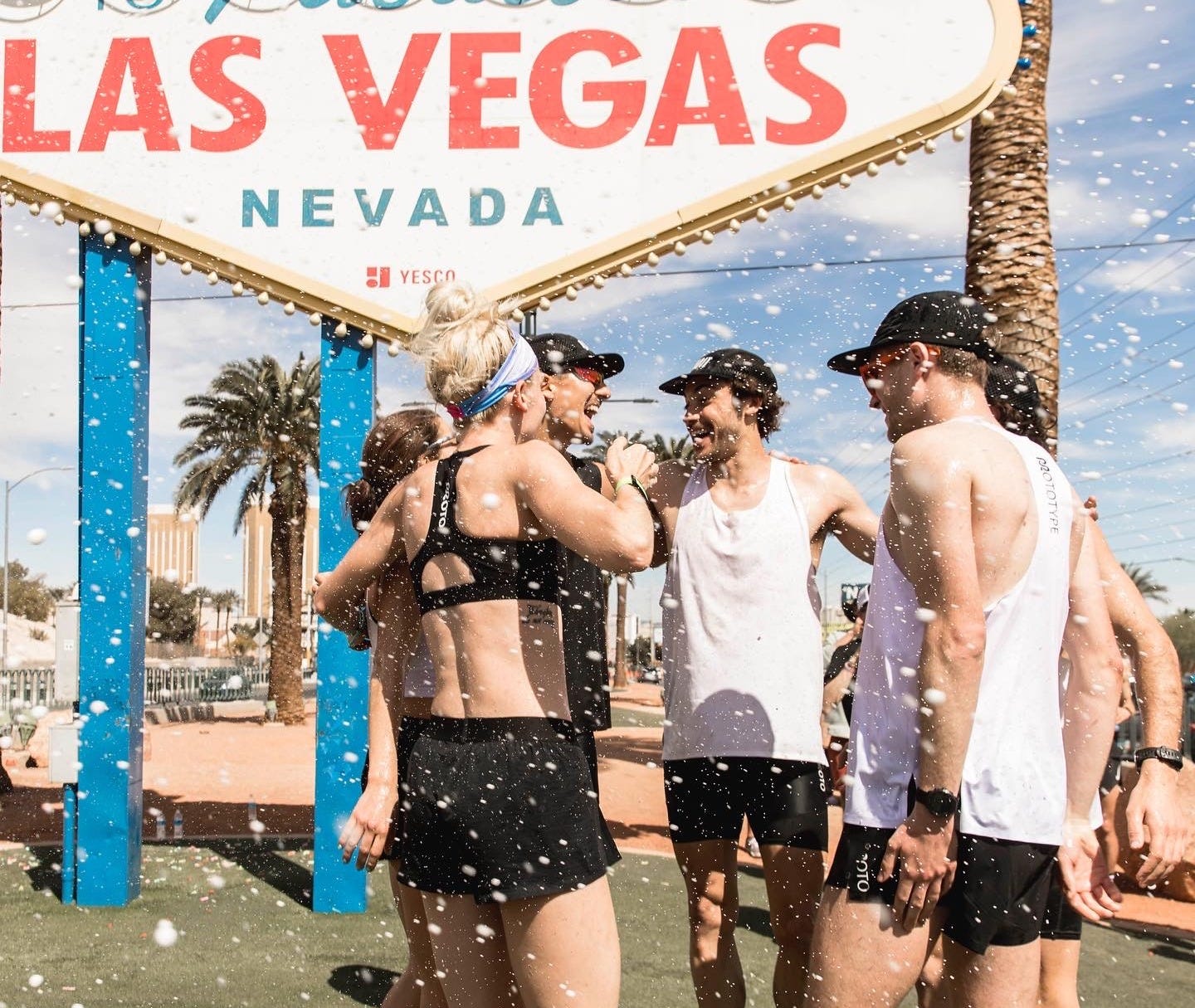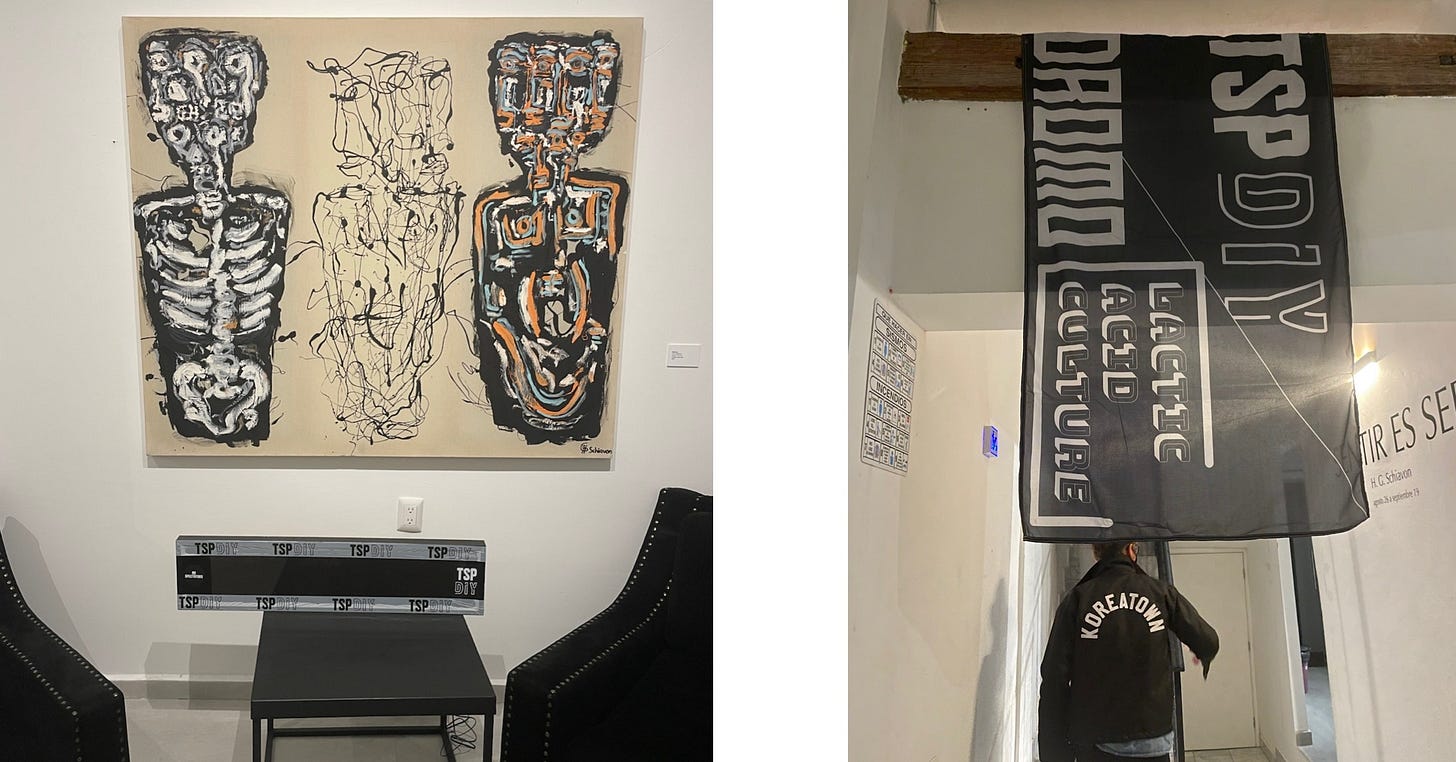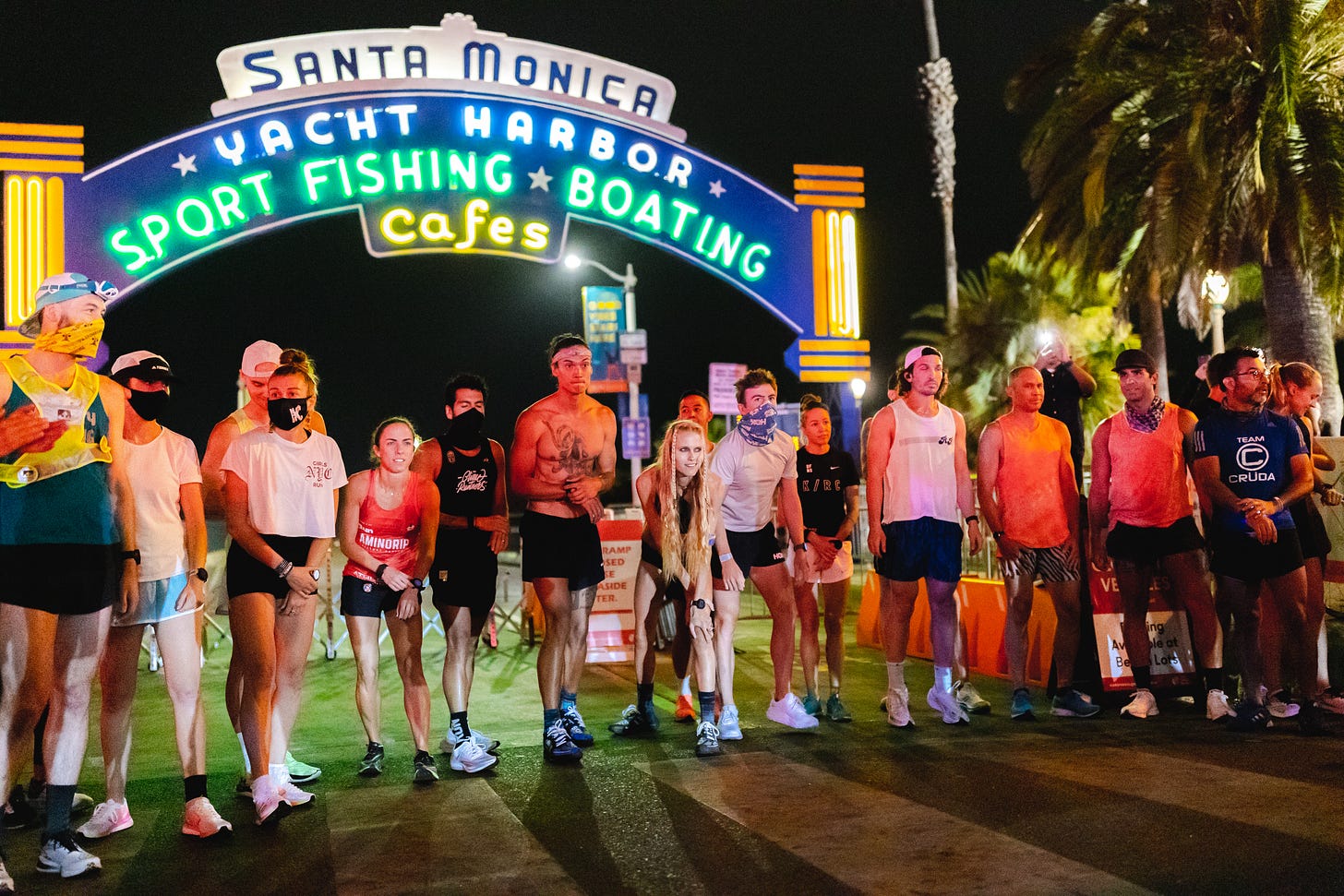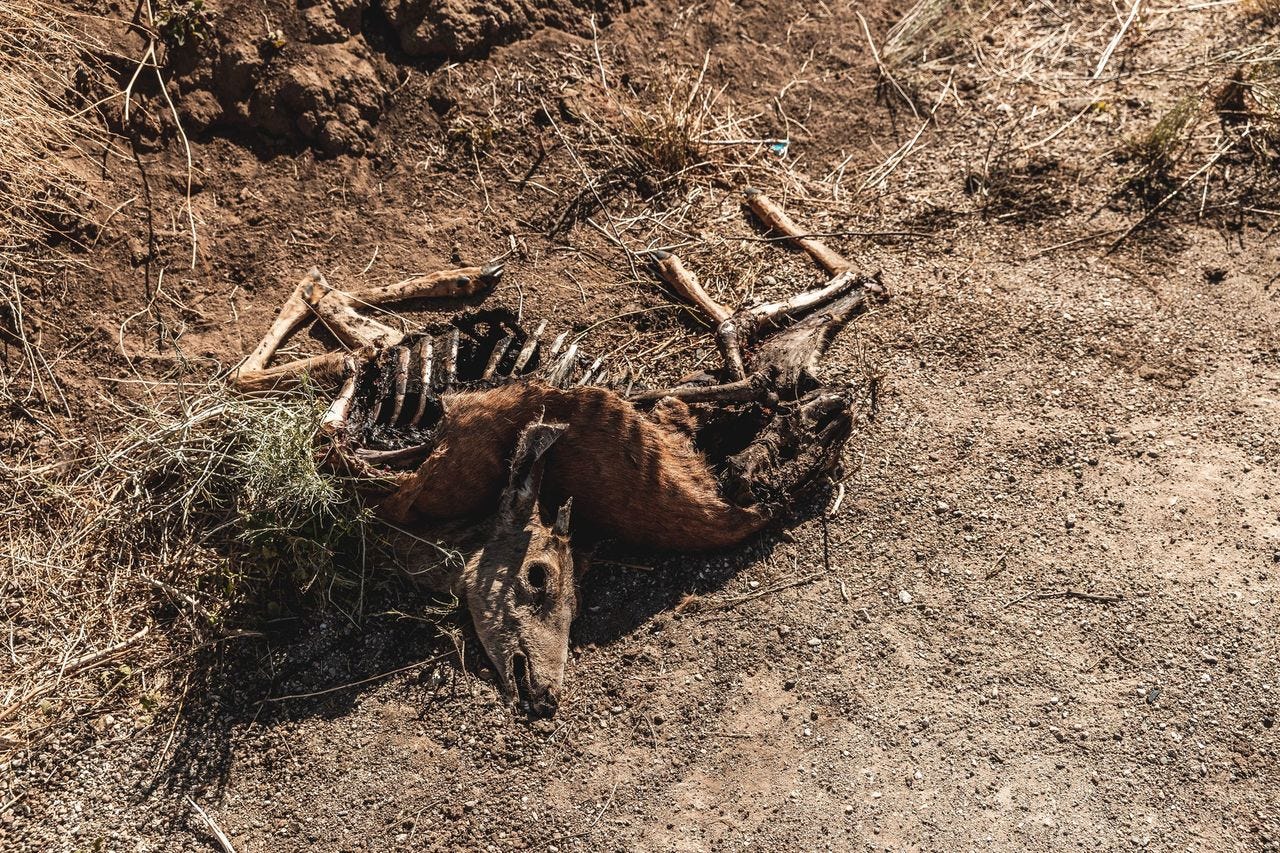The Speed Project Still Isn't For Sale
I sat down with TSP founder Nils Arend to talk about brand partnerships within running, the growth of the sport, and the future of the world’s most sought-after unsanctioned running event.

It’s that time of year again. The season of The Speed Project, when runners from across the world gather at the Santa Monica Pier to race on foot from LA to Las Vegas. The Speed Project season coincides with the start of spring and there’s always an acceleration of energy and curiosity within the running community. Who’s racing this year? Will there be another “secret” TSP route? What brands will step foot into this unpredictable ring?
I had the chance to sit down with Nils Arend, founder of TSP, to dig a little deeper into the TSP brand and why they continue to do things radically different than any other event organization. This conversation was inspired by a recent IG reel Nils posted addressing a negative experience with a brand that tried to undercut his work without proper compensation. In a followup post, Nils explained an amiable resolution had been made, but I do wonder if Nils hadn’t gone public with it, would there have been a different outcome?
This example highlights a larger issue with bigger companies taking advantage of smaller, grassroots brands within running to try and latch on to cooler, underground movements. I think it’s great if large corporations can collaborate with smaller entities (smaller brand gets more exposure, bigger brand gets access to niche audience). However, it can backfire when said big brand doesn’t respect the soul and community of the smaller brand.
If you know Nils, you know he’s a pretty behind the scenes guy, and somewhat mysterious. So I’m really happy we got to catch up and chat about the current state of TSP and more broadly, the state of brand partnerships within running.
If You Can’t Respect TSP’s Boundaries, Then Don’t Apply
The irony of “No Rules, No Spectators” is that there definitely are rules when it comes to brand participation. What Nils is really doing is protecting the purity of The Speed Project, so that no one can monopolize the event for their own benefit, whether they’re a big corporation or an individual athlete.
Is Nils too protective of TSP? To play devil’s advocate, sure. In my own experience, Nils and I butted heads when WHOOP participated in TSP in 2021. I had my set list of deliverables and expectations for how I thought WHOOP should be infused into the TSP livestream and updates. That’s the pressure we face in marketing, to make sure we achieve ROI. Part of the agreement was having all the solo runners wear WHOOP during their 5-day journey in the desert, so we could monitor their effort, recovery, and sleep trends. It was a cool activation, but it was unlike any event sponsorship I’d ever managed before. It required me to be understanding of Nils’ non-negotiables and trust that a less traditional, creative approach would work.
It took me a while to appreciate where Nils was coming from. His ability to say “no” and put his foot down is his biggest strength with TSP, and also the biggest turn off for a lot of brands who feel entitled to TSP intellectual property. Over the last 12 years of TSP’s existence, Nils has been able to weed out the wrong partners and attract those who are committed to creating value for the run community, instead of trying to make a quick profit.
“Is it tough? 100%. There was a moment a couple years back where I had our typical kind of conversation with a brand manager and I explained how we do things, and they were just not getting it,” said Nils. “And I hung up from that phone call so aggravated and I was like, fuck brands, fuck this shit, no more fucking brands at The Speed Project, right?”
“So what do I do in those moments? I go for a run and recalibrate and I mentally took a step back and was like, why do we exist? The Speed Project exists because in 2013 we traveled from LA to Vegas on foot and we came across something magical. We took on the responsibility to share that magic with others,” said Nils.
“Is it tough? 100%.” - Nils on maintaining the purity of TSP.
That magic is what so many people are after in running, and Nils is very much aware that it’s attractive to a lot of companies. What TSP has done successfully is create a globally-recognized, highly sought-after event that flips event marketing completely upside-down and puts all that time and energy into creating an irreplaceable athlete experience. The athletes are the drivers of innovation, literally. They are creating the routes, documenting their experience, and thrown into the adventure and the suffering without a lot of structure. You will never, ever find another experience quite like TSP, and that’s why it’s such a valuable property from a business perspective. Companies spend a lot of money to get something close to even a fraction of what TSP offers to participants in terms of community, raw human emotion, and storytelling. The brands that find creative ways to leverage the athletes and build community are the ones who get the most out of the TSP partnership.

“We set a framework on how brands can engage with our participants and engage with us as an organization through the lens of no spectators, which stands for radical participation. That kind of framework has worked over the years, because our intention with athletes is to remove as many guardrails as possible to allow them to come in and make it their own,” said Nils.
“With brands, the moment they step into our space, we have to have very clear guidelines on what they’re allowed to do and what they’re not allowed to do in order to protect the soul, the energy.”
The Long-Standing Relationship With Ciele Athletics
While Nils has very strict guidelines on brand participation, he recognizes that they’re essential for TSP as an organization, because ultimately they are supporting the athletes. A brand sponsoring a team will pay around $10,000 to cover travel, transportation, food, entry fees, and the penultimate pool party in Vegas. When you factor in content production and distribution rights set forth by TSP, you’re getting close to $30,000. Brands are an essential part of financially backing TSP, and teams running can secure as many sponsors as they’d like to cover these costs.
He cites his relationship with Ciele Athletics as the best example of brand collaboration with TSP. Ciele has participated in TSP since 2019, investing in a variety of activations, creative content, and product collaborations. Most notably, TSP launched the LALV grant program with Ciele, which allows runners who don’t have the financial means to participate to get support.
“There’s such a deep level of trust. There’s such intention behind everything we do with them,” he explained. For Nils, collaborating with brands is all about the long-term relationship. “We’re not in the game for one-night stands.”
Nils has also collaborated on apparel with Ciele, including the GOCap “No Spectators” edition.
Does The Speed Project Make Money? And Is It Safe?
On the outside, you might be asking how does TSP make money, and how has it existed for so long without any title sponsors, no support along the course, and no major accidents? I’ve wondered the same thing myself.
As mysterious as Nils can be with his elusive whereabouts (he told me he’s in Costa Rica now and doesn’t really go back to LA often) and non-traditional creative projects, he was pretty transparent with me on how it’s possible for him to keep TSP going.
“I had the luxury to start Speed Project without any financial pressure. I ran a creative studio and had access to those resources. We were able to run Speed Project for many years through those resources without any overhead, which allowed us to build the foundation where we are now,” he explained. “In 2020, we brought someone on board for the first time where we committed to a salary. And now we have a team of a few that works year round.”
Despite being very established, Nils says they’re still in the red in terms of how much effort they put in versus how much money TSP is generating. The small team, which includes Nils, Scotty Crowe, Jarick Walker, and Patricia Covarrubia, is producing a ton of creative work, including films, magazines, and storytelling moments for TSP and the running community at large.

“There’s a point of view in society that if you do good, you shouldn’t benefit from it financially. And that’s something I absolutely disagree with. Do we have the intention to become financially stable and profitable in what we do? A hundred percent, and I think that’s nothing to shy away from. Is Speed Project a humming business that is making tons of cash? I can tell you, unfortunately it’s not, but it should be.”
There’s also the question of safety and logistics. I always found it amusing that TSP never bothered with event permits in Santa Monica, and 60-something giant RVs would be parked along Ocean at 3am in the morning, ready to drive to Vegas. When I ran in 2022, there was a guy selling homemade pop tarts and coffee on the sidewalk to all the runners, and at least 10 simultaneous photoshoots happening as everyone was warming up in the streets. The Santa Monica police have come before to figure out what all the commotion was about, but there’s nothing they can do since none of it’s really illegal. And LA has too much other shit going on for police to care about a couple hundred runners trekking 340 miles to Las Vegas.
When running along the streets past strip malls in Hollywood and long stretches of empty desert in Death Valley, you’re completely alone. You could probably die. When it’s dark and the stars are your only source of light as you run through sandy paths next to the highway, you question if you’ll get bit by a snake or trip over loose barbed wire. There’s no cell service and all you can do is keep moving.
“The weeks when we have runners out there are probably the weeks where I’m aging the most.” - Nils Arend, founder of The Speed Project
“The nature of what TSP is, is very dangerous, you know? We’re reflecting on that every step of the way and making sure we feel okay to expose our community to that danger. We are doing everything we can to ensure that folks who are participating understand what they’re getting themselves into. We’ve put a lot of effort into conversation, safety briefings, best practices, and ensuring that everyone who comes to TSP understands that.”
“The weeks when we have runners out there are probably the weeks where I’m aging the most,” Nils told me. “It’s always scary. There’s always an element of like, I don’t know if I can do another one of these. Being sleep deprived, being on call, getting tough calls and the safety of our participants on top of mind at every minute throughout the day. And what if the authorities are trying to shut us down?”
In the 12 years TSP has been operating, it hasn’t had a single accident. Yes, people get stuck in the sand and need to call tow trucks, and plenty of people get injured from the combination of high mileage and sleep deprivation. I’m sure a lot of people have had to pay for damages to their RVs, too (we broke a door by accident when I crewed team Take The Bridge). But no one’s been seriously injured, crashed a vehicle, been attacked by animals, or died. Personally, I think it speaks to the community because no one wants this thing to get canceled. Everyone is looking out for each other, stepping up when someone else can’t run, and taking extreme caution to keep everyone safe.
Who Is Allowed to Run TSP?
Well, anyone. However, there is a selection process on who makes the final cut, and that’s carefully curated by Nils and his small creative team. Historically, that’s pissed people off because it can feel exclusionary. You can’t just register for TSP and show up at the starting line. You likely have to be deeply involved in the running community, or maybe you’re new to the scene, but you represent running in a positive way.
“We look at the curation of the field, not through the lens of how many fucking followers you have, but what’s your motivation to come? The richer the answer, the more likely it is that you’re going to participate in TSP.”
As my friend Gordon Clark and TSP veteran says, The Speed Project is “The Oscars of Running.” TSP is quite literally the pulse of who’s relevant in amateur running and which running brands are on the rise. Although it attracts the creatives, the game changers, and the cool brands, Nils says the essence of TSP isn’t about that.
“On the surface, we’re known for the epic shots, right? So naturally influencers probably gravitate towards us,” Nils admits. “We look at the curation of the field, not through the lens of how many fucking followers you have, but what’s your motivation to come? The richer the answer, the more likely it is that you’re going to participate in TSP.”
“I think it’s funny to see how many people who are not part of the core sport now participating in the sport. So like, do I have a personal feeling about Diplo’s Run Clubs? Sure, I think it’s great that this happens. I’m absolutely supportive of any and all fucking running influencers, DJs, you name it. Like they should all run. And they should rally their community behind it. I’m a thousand percent supportive.”
“That allows us to maintain this level of hype, this level of growth in the sport, the level of exposure we’re getting. So how can we collectively maintain that?”
The Future of TSP
As TSP grows, so does running in general. I truly believe we’re living in the Golden Ages of running. Every brand wants to be involved with running, even the non-endemic ones (have you seen Zara’s new carbon-plated shoes?). With growth comes the need for checks and balances. Why do we create these running experiences? Are we being inclusive, while honoring the integrity of the sport?
Nils envisions creating a “steering committee” that helps and protects the sport. “That’s been top of mind for me,” he said. “In what form could the sport come together to protect its soul while we’re going through this growth period. I would love to put some energy and headspace towards that, but I haven’t found the right partners yet.”
One thing he knows for sure though, is that TSP will be here for a long, long time. There’s no 5-year plan or exit strategy. Their slogan, “It was better next year” is a play on words to remind everyone to stay in the present, because everything TSP does is unpredictable.
“We want to continue having this pioneering spirit. I’m looking towards different spaces in the world that inspire me and inform me. We have a very committed team that is highly invested in this, and participants as well. This combination is a beautiful place to be in, and we want to continue leaning into it.”
Follow @thespeedproject and @nils_877 to keep up with this year’s LALV race happening end of March.







Takes a lot of integrity to hold the fort down the way he does. Super nice to know a little more. Would love to see global events.
Great piece!